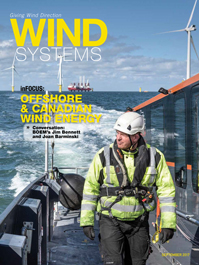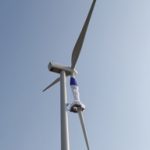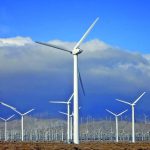At the end of July, Siemens Gamesa Renewable Energy released its third-quarter of fiscal year 2017 results1 (from April to June 2017).
During this period, the company has accelerated its integration program. The announced synergies of 230 million euros are now the ‘minimum,’ and the company expects to realize these synergies in year three, one year earlier than previously announced.
“We are highly satisfied with the progress to date in integrating the two companies,” said Markus Tacke, CEO of Siemens Gamesa. “Things are progressing at a rapid rate; our company is ready to compete and lead in a growing and challenging market.”
Regarding the financial performance, in the third quarter of fiscal year 2017, Siemens Gamesa Renewable Energy’s revenues amounted to 2.693 million euros, down 7 percent year-on-year, while underlying EBIT3 came to 211 million euros (-21 percent) with the margin at 7.8 percent. These results were affected by specific onshore market conditions, including the temporary suspension of the Indian market. Stripping the impact of India, revenues were up 1.6 percent with a strong 8.6 percent growth in underlying EBIT margin.
Siemens Gamesa key figures April-June 20172 (vs. Apr.-Jun. 2016):
Figures in euros
- Revenues: 2.693 million (-7%)
- Sales: 1.950 MW (-25%)
- Underlying EBIT3: 211 million (-21%)
- Underlying EBIT margin: 7.8% (-1.3%)
- Underlying net profit: 135 million
- Net cash: 236 million
Commercial activity and profitability
In the third quarter, revenue from the sale of wind turbines decreased by 9 percent to 2.393 million euros, reflecting lower sales volumes of 1.950 MW (-25 percent), as a result of temporary market conditions in the onshore business, as well as normal business volatility in the offshore market. In India, the market shut down pending a revamp of the auction system, which is expecting to normalize by the first quarter of fiscal year 2018.
Overall, the company expects an improvement in the renewable energy sector. Demand prospects remain positive; emerging markets continue to play a particularly important role, and the renewal of auctions is reactivating mature markets — for example, Southern Europe — and activating new markets such as Argentina and Russia. Excluding China, the global market demand for installations is expected to increase by 8 percent from 36 GW in 2017 to 45 GW in 2020.
Siemens Gamesa continues to lead the offshore segment having installed 10 GW, nearly 70 percent of the global offshore fleet and anticipates strong growth of more than 24 percent annually in offshore installations until 2020. The medium term prospects remain positive with an agreement reached this quarter with Dong for the construction of the Borssele 1 and 2 wind farms, involving 94 turbines (756 MW) to be commissioned by the end of 2020.
The O&M service revenue expanded by 8 percent to 300 million euros with an underlying margin of 16.7 percent. The fleet under maintenance continued to grow, reaching 54 GW worldwide (+13 percent).
In this specific market context, Siemens Gamesa obtained 135 million euros of underlying net profit between April and June, equivalent to 0.2 euros per share. Underlying EBIT3 declined 21 percent to 211 million euros while the underlying EBIT margin was constant at 7.8 percent. These figures were also affected by the disruption in business activity in India, which is expected to normalize by the first quarter of fiscal year 2018.
The company continues to strengthen its balance sheet and ended the quarter with a net cash position of 236 million euros.
New onshore CEO
Ricardo Chocarro was named CEO of the company’s onshore business. For the past 18 years, Chocarro has held responsibilities at former Gamesa and since 2013 has served as CEO of the Europe, Middle East, and Africa (EMEA) business.
“I am honored to be appointed for this responsibility,” Chocarro said. “We already play an important role in the global onshore renewable energy marketplace. I am convinced that we are prepared to lead the sector and take advantage of future growth.”
Chocarro has replaced Xabier Etxeberria, who leaves the company after five years of success and a major contribution to its development. Etxeberria has decided to pursue a new professional challenge.
“It has been a tremendous honor working for this great company during the last five years,” Etxeberria said.
Moving forward
The integration process is confirming the company’s huge potential thanks to its bigger scale and global reach: a presence in more than 90 countries, an installed base of 75 GW, and a strong order book of 21 billion euros. Siemens Gamesa CEO Markus Tacke said the company has “a very strong global presence, underpinned by solid relationships with customers around the world, a global supply chain, and a broad manufacturing footprint. We have some of the most reliable and efficient products in the industry.”
All integration efforts are on track. The company is reorganizing departments; taking first steps about product portfolio, supply chain, and manufacturing footprint. In this sense, Siemens Gamesa agreed to integrate Adwen within the group’s broader offshore operations, which will allow it to better serve its customers and maximize business opportunities.
The company will announce its new strategic plan on November 15 at a Capital Markets Day. At that time, Siemens Gamesa will provide the product portfolio, the financial targets for fiscal years 2018-2020, as well as a global sales plan and a model for the future supply chain footprint.
REFERENCES
- Siemens Gamesa’s financial year runs to the end of September.
- Financial data are non-audited pro-forma, based on legacy business reported information including standalone, normalization and scope adjustments for Siemens Wind Power operations, amounting to 29 million euros. Adwen is fully consolidated.
- Data exclude integration costs for 36 million euros and PPA for 124 million euros at EBIT level and 87 million euros at net income level (net of taxes)
Source: Siemens Gamesa
For more information, go to www.siemens.com

































